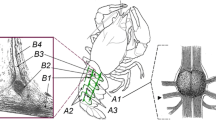Summary
Non-encapsulated, fine beaded nerve endings were found histologically on some muscle fibres in a number of limb muscles in newts and axolotls. They were present in newt muscles that had been chronically de-efferented, and in which no efferent activity survived, and were therefore likely to be sensory. They were located only on muscle fibres on or near the outside surface of the muscle. These small-diameter muscle fibres were characterised histochemically by low lipid, SDH and phosphorylase content; ultrastructurally by low glycogen content, and relatively large myofilaments poorly delimited by a sparse SR. There were many of this type (Type 1) that did not support sensory endings. A few endings occurred on another larger-diameter type of fibre (Type 2) whose properties were opposite to those listed above for Type 1. There was virtually no specialization of muscle fibre structure beneath the sensory endings.
Physiological experiments involving ramp-and-hold and sinusoidal stretch applied to the muscle whilst recording single-unit afferent responses in m.ext. dig. III of axolotls showed unit responses very similar to those known from muscle spindles, particularly those of the frog.
Similar content being viewed by others
References
Adrian, R.H.: The effect of internal and external potassium concentration on the membrane potential of frog muscle. J. Physiol. 133, 631–658 (1956)
Bach-y-Rita, P., Ito, F.: Properties of stretch receptors in cat extraocular muscles. J. Physiol. 186, 663–688 (1966)
Barker, D.: The morphology of the muscle receptors. In: Handbook of Sensory Physiology, Vol. III/2 (C.C. Hunt ed.) 1–190. Berlin-Heidelberg-New York: Springer 1974
Best, A.C.G., Bone, Q.: The terminal neuromuscular junctions of lower chordates. Z. Zellforsch. 143, 495–504 (1973)
Brown, M.C., Engberg, I., Matthews, P.B.C.: The relative sensitivity to vibration of muscle receptors of the cat. J. Physiol. 192, 773–800 (1967)
Cliff, G.S., Ridge, R.M.A.P.: Innervation of extrafusal and intrafusal fibres in snake muscle. J. Physiol. 233, 1–18 (1973)
Cooper, S., Fillenz, M.: Afferent discharges in response to stretch from the extraocular muscles of the cat and monkey and the innervation of these muscles. J. Physiol. 127, 400–413 (1955)
Crowe, A., Matthews, P.B.C.: The effects of stimulation of static and dynamic fusimotor fibres on the response to stretching of the primary endings of muscle spindles. J. Physiol. 174, 109–131 (1964)
Crowe, A., Ragab, A.H.M.F.: Studies on the fine structure of the capsular region of the tortoise muscle spindles. J. Anat. 107, 257–269 (1970)
Earle, J.: In “Cell and Tissue Culture” (Paul, J. ed.) 2nd edn. Williams & Wilkins 1943
Eränckö, O., Palkama, A.: Improved localization of phosphorylase by the use of polyvinyl pyrrolidone and high substrate concentration. J. Histochem. Cytochem. 9, 585 (1961)
Francis, E.T.B.: The anatomy of the salamander. Oxford: Clarendon Press 1934
Franque, O. von.: Beiträge zur Kenntnis der Muskelknospen. Verh. phys. med. Ges. Würzburg 24, 1–30 (1890)
Fukami, Y.: Tonic and phasic muscle spindles in snake. J. Neurophysiol. 33, 28–35 (1970)
Giacomini, E.: Sulla maniera onde i nervi si terminano nei miocommi e nella estremità delle fibre muscolari dei miomeri negli Anfibii urodeli (Accad. fisiocrit. Siena, 30 mars), Monit. Zool. Ital IX, 92–95 (1898)
Hammond, G.R.: A study of post-tetanic potentiation and depression of isometric twitch contractions in single motor units of snake muscle. Ph. D. Thesis, Univ. Bristol 1974
Ito, F.: Functional properties of leaf-like muscle receptors in the frog sartorius muscle. Jap. J. Physiol. 18, 590–600 (1968)
Ito, F., Toyama, K., Ito, R.: A comparative study on structure and function between the extrafusal receptor and the spindle receptor in the frog. Jap. J. Physiol. 14, 12–33 (1964)
Katz, B.: The terminations of the afferent nerve fibres in the muscle spindle of the frog. Phil. Trans. R. Soc. B,243, 221–240 (1961)
Mather, V., Hines, M.: Studies in the innervation of skeletal muscle; V. the limb muscles of the newt, Triturus torosus. Amer. J. Anat. 54, 177–196 (1934)
Matthews, B., Searle, B.N.: An amplitude discriminator and an instantaneous frequency display. J. Physiol. 224, 3P (1972)
Nachlas, M.M., Tsou, K.-C, de Soriza, E., Cheng, C.-S., Seligman, A.M.: Cytochemical demonstration of succinic dehydrogenase by the use of a new p-Nitrophenyl substituted ditetrazole. J. Histochem. Cytochem. 5, 420–436 (1957)
Ottoson, D.: Functional properties of a muscle spindle with no fluid space. Brain Res. 41, 471–474 (1972)
Pallot, D.J.: Structural and functional studies on snake muscle spindles. Ph. D. Thesis, Univ. Bristol 1973
Pallot, D.J., Ridge, R.M.A.P.: The fine structure of the long-capsule muscle spindles in the snake Natrix sp. J. Anat. 113, 61–74 (1972)
Proske, U.: An electrophysiological analysis of responses from lizard muscle spindles. J. Physiol. 205, 289–304 (1969)
Shepherd, G.M., Ottoson, D.: Response of the isolated muscle spindle to different rates of stretching. Cold Spr. Harb. Symp. Quant. Biol. 30, 95–103 (1965)
Smith, G.M.: The detailed anatomy of Triturus torosus. Trans. Roy. Soc. Canada (3rd series) 21, sec. v, 451–484 (1927)
Smith, R.S.: Sensory transduction in frog muscle spindles: role of the intrafusal muscle fibers. In: Research in muscle development and the muscle spindle. (B.Q. Banker, R.J. Przybylski, J.P. van der Meulen and M. Victor eds.) Excerpta Medica 1972
Smith, R.S., Ovalle, W.K.: Varieties of fast and slow extrafusal muscle fibres in amphibian hind limb muscles. J. Anat. 116, 1 -24 (1973)
Winkelmann, R.K., Schmitt, R.W.: A simple silver method for nerve axoplasm. Proc. Mayo Clinic 32, 217–222 (1957)
Author information
Authors and Affiliations
Additional information
We are grateful to the M.R.C. for an equipment grant (to R.M.A.P.R.), and to Mrs. Janis Taberner for her technical help. Part of this work was done during the tenure of a Nuffield-NRC Lectureship (Q.B.) which is gratefully acknowledged, as is financial support by Prof. J.R. Nussall during a visit to the University of Alberta at Edmonton.
Rights and permissions
About this article
Cite this article
Bone, Q., Ridge, R.M.A.P. & Ryan, K.P. Stretch receptors in urodele limb muscles. Cell Tissue Res. 165, 249–266 (1976). https://doi.org/10.1007/BF00226663
Received:
Revised:
Issue Date:
DOI: https://doi.org/10.1007/BF00226663




